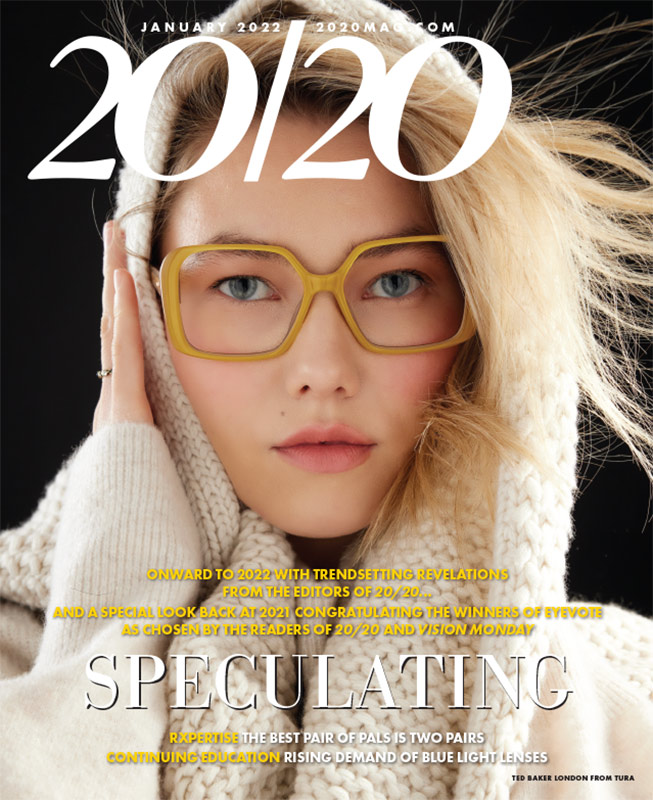Linda Conlin, ABOC, NCLEC

Eyewear covers 25 percent or more of the face and masks the most expressive part of our appearance—our eyes. Is it any wonder people are sensitive to the way they look in new eyewear? Your challenge is to give patients the best combination of looking good and seeing well in new eyewear. Experience and intuition can lead to good cosmetic results to help achieve a “look” that patients will appreciate without sacrificing eyewear performance.
Style
Personal style is an extension of personality, and eyewear choices follow that extension. Note how the patient is dressed. Is it colorful? Conservative? Fun? Casual? How are they accessorized? Those clues can help you guide the patient to collections that suit their taste. The patient’s complexion and wardrobe preferences should always be considered when selecting the material and color of the frame. Style conscious patients will usually be able to make appropriate choices in color and texture of frame materials.
Why is the fashion factor so important? As ECPs, we recommend products based on useful features, but we get ahead of ourselves because the consumer is not interested in rational reasons until they buy in emotionally. The response is less about the physical product and more about how that product will make their life better, cooler, more fun and more fulfilling. For this reason, appealing to patients’ desire to be fashionable while having fun in their “cool” high-tech lenses will elicit an emotional response and purchase commitment. Job number one is knowing what frame styles your patients want that will fit, look great and be seen as good value while not posing unnecessary challenges for more difficult prescriptions. In other words, you must carefully curate every frame you carry.
Vision
Deciding on the right lens helps guide the frame selection process. The patient eyewear experience is more than finding a frame that fits; the lenses are a crucial part of the total eyewear package. ECPs help patients find a comfortable balance between fashion and function. By staying attuned to their patients’ needs, they can strike that perfect harmony. Frames are a choice, but lenses are prescribed.
Today, as Rx eyewear becomes impacted by the exponential growth of freeform surfacing and high precision lens making, it’s an opportune time to consider whether we are truly using all the high-tech tools at our disposal to strike the optimal balance between optics and cosmetics. How the lenses will be used will point you to a lens style. Power will determine lens material and design. The patient’s previous pair of glasses will give you great information about designing their new lenses. Was there anything they didn’t like about them and what do they expect from their new glasses? If the previous pair didn’t match expectations, find out why. Consider a digital aspheric design if the prescription is a high power or cylinder.
The eyeglass consumer places a premium on seeing well and looking well in their glasses, both of which premium AR treatment enhances. Some practices report AR sales as high as 95 percent, with the primary reason being the premium placed on aesthetics. Seeing their best and being seen at their best: AR treatments enhance vision by allowing maximum light to transmit through the lens. Another benefit of AR is the elimination of reflected glare on all surfaces and internally. Lens surface and internal reflections contribute to poor night vision, ghosting and halos. Surface reflections from a lens without an AR treatment will obscure the view of the wearer’s eyes. AR treatments let others see their eyes instead of the glaring reflection from lenses without AR.
Comfort
In addition to style and vision, comfort is important. Temples that are too short, for women as well as men, will result in a frame that fits too tight or slides down. Similarly, a poorly fitting bridge will have that patient back in your shop in no time. Steer patients away from frames that will require considerable adjustment to achieve a good fit. If you have to compensate for the way the frame fits before the glasses are made, you have the wrong frame. Anti-slip adaptive nosepads, contoured end tips, shape memory functions, lightweight materials and flexibility ensure an excellent fit for faces of all shapes and sizes.
Today’s eyewear consumer wants style, vision and comfort. Matching your patient with the right frame and the right lens will result in a happy, loyal patient who will likely bring you referrals.













